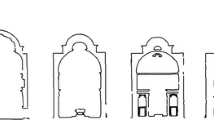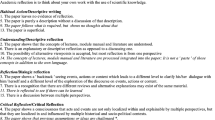Abstract
The chapter discusses the processes of a designer’s reflection-in-action when employing simulation-based design tools. It revisits Donald Schön’s seminal work on the Reflective Practitioner, considering the current technological mileu where simulations of physical or environmental behavior educate future architects on how to reflect in action during the design process, rather than analyzing and modifying their design a posteriori. Schön argues in favor of the idiosyncratic element in design decision making which is based on practice. Hence, the digital practitioner of our times develops an intuition and knowledge that derives from the exposure to simulations and computational tools. The chapter will expound on processes of experiential learning in architecture and discuss the findings and experiences from architectural studio case studies that employed computational tools for form-finding to provide real-time feedback on the behaviour and geometry of the projects. The curriculum aimed at combining teaching strategies, digital media and design processes towards the objective of educating the reflective digital practitioner of the future.
Access this chapter
Tax calculation will be finalised at checkout
Purchases are for personal use only
Similar content being viewed by others
Notes
- 1.
Digital Natives refer to the students today, as they are all “native speakers” of the digital language of computers, video games and the Internet [13].
- 2.
Digital Immigrants learn—like all immigrants, some better than others—to adapt to their environment, they always retain, to some degree, their “accent,” that is, their foot in the past [13].
- 3.
Kolb’s Cycle comprises of 4 stages: 1. Concrete Experience 2. Reflective Observation 3. Abstract Conceptualization 4. Active Experimentation.
- 4.
There have been several variants of Dale’s Cone of Experience, some of which are known as the Pyramid of Knowledge, offering percentages of the learner’s ability to retain knowledge. However, such adaptations of the original model are not based on scientific research and are falsely presented by researchers as evidence about knowledge retention. The original model by Dale as presented in the book is not aiming to be presented as the outcome of scientific model, it is suggested as a conceptual, visual model.
References
Schon, D.A.: The Reflective Practitioner: How Professionals Think In Action. Basic Books, New York (1984)
Gropius, W.: Scope of Total Architecture. Collier Books (1962)
Al-Qawasmi, J., Velasco, G.P.V. de: Changing Trends in Architectural Design Education. csaar (2006)
Dowdle, D., Ahmed, V.: Teaching and Learning Building Design and Construction. Routledge (2013)
Dutton, T.A.: Voices in Architectural Education: Cultural Politics and Pedagogy. Praeger, New York (1991)
Harriss, H., Widder, L. (eds.): Architecture Live Projects: Pedagogy into Practice. Routledge, Oxon, New York, NY (2014)
Nicol, D., Pilling, S. (eds.): Changing Architectural Education: Towards a New Professionalism. Taylor & Francis, London, New York (2000)
Salama, A.: A theory for integrating knowledge in architectural design education. ArchNet-IJAR: Int. J. Arch. Res. 2, 100–128 (2008)
Salama, A.M.A., Wilkinson, N.: Design Studio Pedagogy: Horizons for the Future. ARTI-ARCH (2007)
Schön, D.A.: Toward a marriage of artistry & applied science in the architectural design studio. J. Arch. Educ. 41, 4–10 (1988)
Waks, L.J.: Donald Schon’s philosophy of design and design Education. Int. J. Technol. Des. Educ. 11, 37–51 (2001)
Webster, H.: Architectural education after Schön: cracks, blurs, boundaries and beyond. J. Educ. Built Environ. 3, 63–74 (2008)
Prensky, M.: Digital natives, digital immigrants part 1. On Horiz. 9, 1–6 (2001)
Lee, K.: Principles of CAD/CAM/CAE. Prentice Hall, Reading, Mass (1999)
Schein, E.H.: Professional Education: Some New Directions. McGraw-Hill, New York (1972)
Weaver, N., O’Reilly, D., Caddick, M.: Preparation and support of part-time teachers Designing a tutor training programme fit for architects. In: Nicol, D., Pilling, S. (eds.) Changing Architectural Education: Towards a New Professionalism. Taylor & Francis, London, New York (2000)
Ackermann, E.: Piaget’s constructivism, Papert’s constructionism: what’s the difference. Futur. Learn. Group Publ. 5, 438 (2001)
Harel, I., Papert, S.: Constructionism. Ablex Publishing, Norwood, N.J. (1991)
Schon, D.A.: Educating the Reflective Practitioner: Toward a New Design for Teaching and Learning in the Professions. Jossey-Bass, San Francisco, Calif (1987)
Piker, D.: Kangaroo: form finding with computational physics. Arch. Des. 83, 136–137 (2013)
Lewis, W.J.: Tension Structures: Form and Behaviour. Thomas Telford (2003)
Symeonidou, I.: Flexible matter: a real-time shape exploration employing analogue and digital form-finding of tensile structures. Int. J. Archit. Comput. 14, 322–332 (2016)
Oxman, N., Rosenberg, J.L.: Material-based design computation: an inquiry into digital simulation of physical material properties as design generators. Int. J. Archit. Comput. 5, 26–44 (2007)
Kolb, D.: Experiential Learning: Experience as the Source of Learning and Development. Prentice Hall, Englewood Cliffs, N.J. (1984)
Symeonidou, I., Gupta, U.: Bending Curvature: Design Research and Experimentation: Analogue and Digital Experiments. LAP LAMBERT Academic Publishing (2012)
Nettelbladt, M.: The Geometry of Bending. Förlag Mårten Nettelbladt, Stockholm, Sweden (2013)
Symeonidou, I.: Analogue and digital form-finding of bending rod structures. Presented at the August 18 (2015)
Menges, A.: Behavior-based computational design methodologies. In: Proceedings of the 31st Annual Conference of the Association for Computer Aided Design in Architecture (ACADIA), Banff, Alberta (2011)
Eigensatz, M., Deuss, M., Schiftner, A., Kilian, M., Mitra, N.J., Pottmann, H., Pauly, M.: Case studies in cost-optimized paneling of architectural freeform surfaces. Adv. Arch. Geom. 2010, 49–72 (2010)
Jiang, C., Tang, C., Tomičí, M., Wallner, J., Pottmann, H.: Interactive modeling of architectural freeform structures: combining geometry with fabrication and statics. In: Block, P., Knippers, J., Mitra, N.J., Wang, W. (eds.) Advances in Architectural Geometry 2014, pp. 95–108. Springer International Publishing, Cham (2015)
Ryle, G., Dennett, D.C.: The Concept of Mind. University Of Chicago Press, Chicago (2000)
Dewey, J.: Experience and Education. Free Press, New York (1997)
Tate, P.J., Keeton, M.T.: Learning by Experience-What, Why, How Morris T. Keeton, Pamela J. Tate Editors. Jossey-Bass (1978)
Polanyi, M.: The Tacit Dimension. University Of Chicago Press, Chicago (1966)
Acknowledgements
The work presented in this chapter is based on doctoral and post-doctoral research projects of the author. The educational experiments took place at Graz University of Technology in Austria and the Department of Architecture of the University of Thessaly in Greece. The author would like to acknowledge the work of the students that participated in the design studios, and express gratitude to colleagues and student assistants for their valuable input.
Author information
Authors and Affiliations
Corresponding author
Editor information
Editors and Affiliations
Rights and permissions
Copyright information
© 2024 The Author(s), under exclusive license to Springer Nature Switzerland AG
About this chapter
Cite this chapter
Symeonidou, I. (2024). Educating the Reflective Digital Practitioner. In: Barberio, M., Colella, M., Figliola, A., Battisti, A. (eds) Architecture and Design for Industry 4.0. Lecture Notes in Mechanical Engineering. Springer, Cham. https://doi.org/10.1007/978-3-031-36922-3_9
Download citation
DOI: https://doi.org/10.1007/978-3-031-36922-3_9
Published:
Publisher Name: Springer, Cham
Print ISBN: 978-3-031-36921-6
Online ISBN: 978-3-031-36922-3
eBook Packages: EngineeringEngineering (R0)




